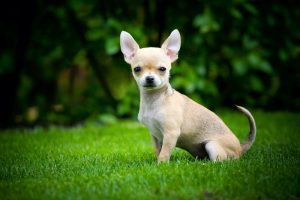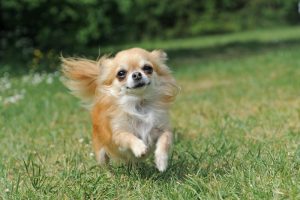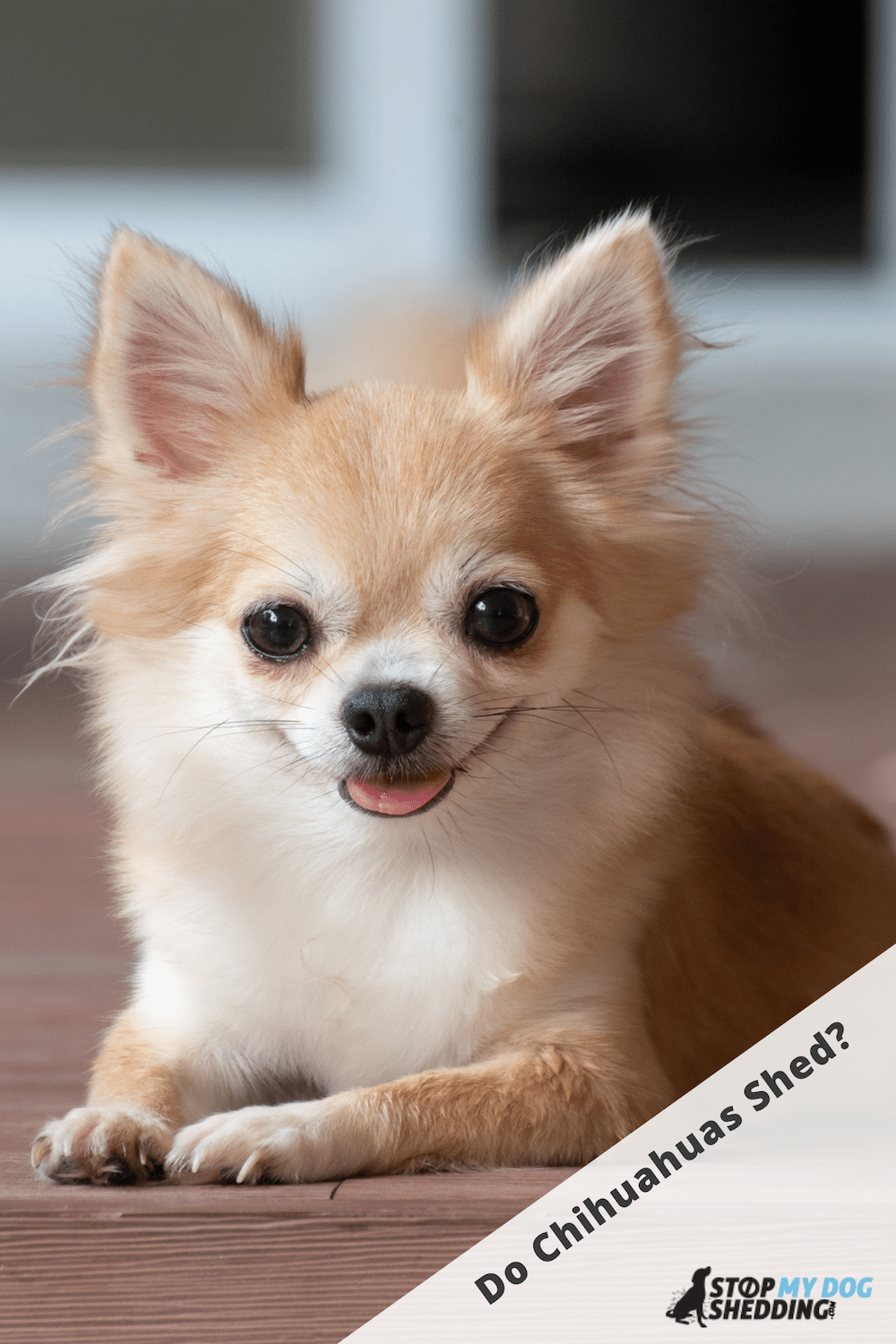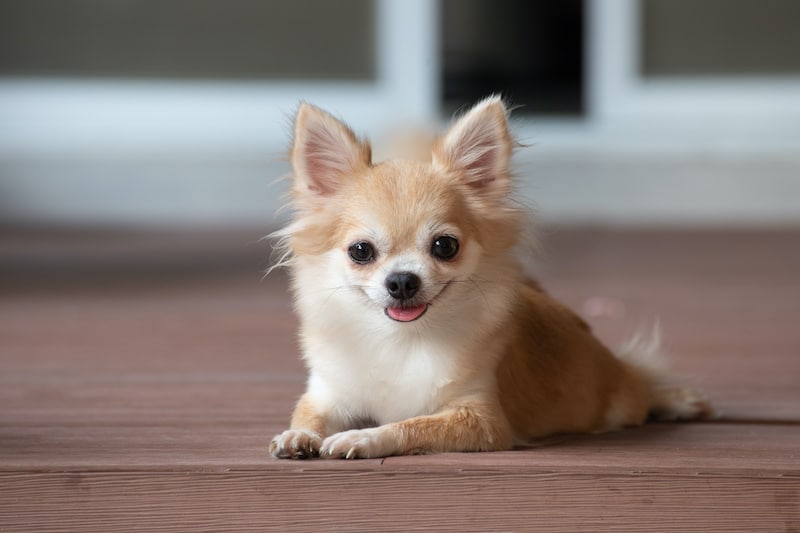Chihuahuas are small dogs that were named after the Mexican state of Chihuahua. They are often described as loyal, charming and bold, like a terrier, and are popular companions.
Do they shed lots? Chihuahuas come in both short and long coat varieties, and some don’t have an undercoat, while others do. So it does depend on which type of Chi you have, but overall they don’t shed very much and aren’t very difficult to groom.
Read on to learn more.
Recommended: Go here to see our top-rated dog hair blow dryers
Chihuahua Shedding Guide
Chihuahuas are a fairly low shedding breed.
It does depend on what coat type they have (long, short, single or double coat) but overall they’re not considered heavy shedders.
There’s not much difference in shedding between the long and short (smooth) coated varieties either. They basically drop the same amount of fur, it’s just a bit more noticeable in the long coated variety since the hair is longer. In reality, the biggest difference is in whether or not your Chi has an undercoat (Chis with an undercoat will shed more).
So, generally speaking, you’ll notice less hair around the home with a short-coated Chihuahua with no undercoat, as opposed to a long-coated Chi with an undercoat. Those are the two extremes. On the flip side, a smooth-coated Chi with a double coat will shed more than one with a long, single coat.


So it depends on the individual Chihuahua. But, overall, they are considered to be fairly low shedding. Meaning you will notice some fur floating around, but with regular brushing it’s not likely to be very noticeable.
How do they compare to other small dogs?
Chis molt about the same amount as small dogs like the Boston Terrier and Bichon Frise. However, thankfully not as much as dogs like the Pomeranian or Pug for example.
Although worth noting is that, if you have a Chi with a double coat, you may notice the shedding is heavier during spring and fall. This is normal with dogs that have a double coat (two layers of fur instead of just one). They are basically just adjusting to the changing seasons by molting their undercoat.
For example, your Chi may shed more heavily in spring because he doesn’t need his thicker winter coat for the summer months ahead. Learn more about seasonal shedding here.
Why do they shed?
Dog shedding (or molting) is a normal process whereby the dog is shedding the old hair to make way for the new hairs. This is known as the hair growth cycle, whichever differs from dog to dog, and this is one of the main things that determine how much a dog sheds. As in, how long it takes for this process to complete.
Other factors that can contribute to shedding include the time of year, whether or not they have an undercoat, and the condition of their coat. And of course, while small dogs shed too, a tiny dog weighing only 6 pounds or less can only shed so much.
With that being said, sometimes excessive shedding can be due to health issues. For example, a Chi that is stressed, having allergic reaction to something, has fleas, isn’t consuming an optimal diet, or has some type of health issue, can shed excessively. So if you are concerned about the shedding, contact your veterinarian.
How can you stop the shedding?
You can’t stop shedding completely, nor should you try, since this is a normal thing that most healthy dogs do. However, there are some simple and practical ways you can minimize the shedding and how much of their fur ends up gathering around the home.
And it’s not very difficult, nor do you need to purchase expensive supplements. Managing the shedding mostly comes down to brushing, bathing and diet.
- Brushing: a regular brushing regime not only removes the old, dead hair from the source, but it helps distribute his skin oils and promote a healthier, stronger coat.
- Bathing: a good bath with a quality dog shampoo can help loosen the dead hairs and make removing these easier with a subsequent brush.
- Proper diet and nutrition: what your dog eats can make a difference, not just to his overall health and wellbeing, but also how much he sheds. Speak with your vet about selecting a high quality dog food.
Is that really all you can do?
There are definitely some other great ways to stop excessive shedding and reduce how much time you spend cleaning it up. Such as using supplements or things like coconut oil, and using a proper vacuum designed for animal hair for example.
But these are the main methods. Despite some clever marketing out there, there is no magic solution to molting. It mostly comes down to the simple things, like grooming and diet, very effective if you implement them properly and consistently.
Grooming Your Chihuahua
Overall, Chihuahuas are fairly low maintenance.
However, as with shedding, the amount of effort needed to maintain their coat does depend on the type of Chi you have.
- Long Coat Chis: these have longer hair that is either wavy or flat, with fringed ears and feathering around the legs and feet. And because their hair is longer, it is subject to mats and knots and generally requires more effort to brush and maintain.
- Short (smooth) Coats Chis: these have short hair that is glossy and close lying. Naturally, this variety is much easier to maintain because their coat is so short.
- Undercoat vs no undercoat: dogs with an undercoat take more time and effort to brush, simply because you are brushing two layers of fur (an outer coat and an undercoat) instead of just one.
What sort of brush should you use?
A metal comb and slicker brush is ideal for the longer coated Chis as these help to remove any mats and tangles, along with their old, loose fur. While a bristle brush is better suited to the smooth coats.
However, during shedding season, you may find a deshedding tool is worth using, especially if your Chi has an undercoat. As these do a good job of reaching right down to the undercoat to remove the loose fur, and they’re fairly easy to use.
See our guide to the different types of dog brushes to learn more.
Aside from the differences in coat, and the different colors in one Chi to the next, both long and short coated Chis are the same dog. And overall, they are not very high maintenance, it’s just that with a longer coat Chi you’ll need to brush a few times per week to maintain their coat and remove any mats.
Aside from brushing, they also need the occasional bath with a good quality dog shampoo, and one that doesn’t dry out the coat. Doing so will help keep your Chi smelling good, remove the dead hairs and help keep his coat looking beautiful.
Can you shave your Chihuahua?
You can trim your Chi and this is what many people with the longer coated varieties do. However, you should never shave your Chihuahua down to the skin unless your vet specifically advises this. Because Chis with an undercoat rely on this to help insulate them in cold and hot weather, and having fur protects them against things like sunburn and mosquito bites.
Bottom Line
Chihuahuas are popular family companions that are small enough to fit in your purse – so cute is an understatement! And thankfully, they don’t shed much and aren’t difficult to groom.
They’re not considered “hypoallergenic” though, which means they’re not the best choice for allergy sufferers. At least, not in comparison to other small, lower shedding dogs like the Italian Greyhound. So there are other amazing dogs worth considering if you’re still deciding.













Please note: By submitting a comment using the above comment form, you confirm that you agree with the storage and handling of your data by this site as detailed in our Privacy Policy.